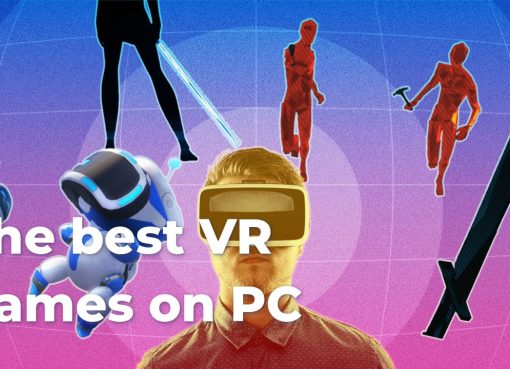Virtual reality gaming reached a new milestone with the release of Half-Life: Alyx. The game, developed by Valve Corporation, breaks traditional boundaries in both storytelling and gameplay mechanics, offering an immersive experience that redefines what VR can achieve.
As a prequel to the iconic Half-Life 2, it enhances the lore with a fresh perspective while leveraging cutting-edge VR technology to bring the environment of City 17 to life like never before. From intricate puzzles and combat mechanics to nuanced interactions with the environment, Half-Life: Alyx sets the bar high for future VR titles.
With its award-winning design and robust community involvement, it isn’t just a game; it’s a transformative experience that promises to be a major cornerstone in the evolution of virtual reality in gaming.
Website: https://www.half-life.com/
Gameplay Mechanics
The hallmark of Half-Life: Alyx lies in its innovative gameplay mechanics, which offer a deeply immersive VR experience. Its mechanics range from environmental interaction and combat to health and ammo management, each finely tuned to enrich the player’s journey.
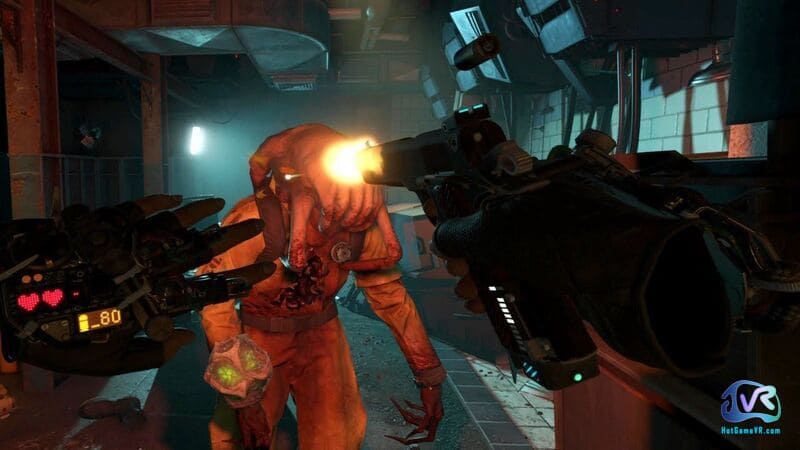
Imagine exploring an astonishingly detailed world where every object is tangible, and enemies are not just a visual treat but a strategic challenge. The game stands out by integrating intuitive metaphors and emotionally engaging elements, making the VR experience not just believable but exhilarating.
Below is a summarized comparison of its standout gameplay features, emphasizing unique elements and technical specifications.
| Feature | Description | Comparison with Traditional FPS |
|---|---|---|
| Exploration | Physical interaction with environment, Gravity Gloves | Much more tactile and engaging |
| Combat | Personal and immersive, enemy AI requires strategic positioning | Less chaotic, requires more strategy |
| Weapon Upgrades | Limited to three types, using Resin | Forces strategic resource allocation |
| Puzzle Mechanics | Integrates VR tools for solving environmental challenges | More physically engaging |
| Health Management | Visual health bar, strategic health kits | Traditional but adds VR specific elements |
| Movement Options | Multiple VR movement methods: Teleport, Shift, Continuous | Customizable to player comfort |
Immersive VR Gameplay
Imagine stepping into the shoes of Alyx Vance, navigating through the intricate maze that is City 17. The immersive VR gameplay in Half-Life: Alyx envelops you completely and makes each movement, each interaction, a tangible experience.
The game employs a variety of mechanisms to achieve this, such as the famous Gravity Gloves. With these nifty gadgets, you’re not just pushing buttons; you’re tugging at distant objects, feeling the weight of each, and even using the terrain to your advantage.
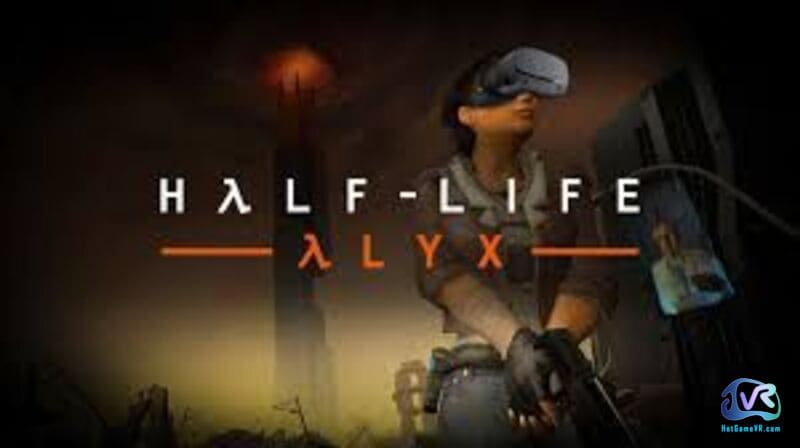
This finely tuned mechanic transforms routine exploration into a dynamic activity, almost as if you’re living within a meticulously constructed dollhouse.
Think of it as stepping into a detailed diorama where every element can be manipulated. You’re not merely a spectator in a meticulously painted world; you’re a participant with physical agency. This layer of immersion adds depth to the already rich environment, enhancing your sense of presence in the world.
Drawing comparisons to other VR games, none have achieved this level of interactivity. For example, while VR titles like Beat Saber offer tactile feedback through rhythm and movement, they lack the narrative complexity and world interaction found here.
Consider engaging in nerve-wracking fire-fights where hiding behind cover isn’t just a button press but a physical necessity. It’s like playing a high-stakes game of hide and seek, where each motion could mean the difference between survival and demise. This heightened sense of realism makes every victory more gratifying.
Adding to this realism is the game’s sound design, which matches the visual fidelity. Imagine walking through an abandoned subway station, the distant echoes of a lurking enemy growing louder with each step. This auditory experience pulls you further into Alyx’s world, making every creak of the floorboard or whispered conversation a crucial part of the game.
By blending intricate gameplay mechanics with a rich, interactive environment, Half-Life: Alyx creates an engrossing VR experience. It sets a high bar, showing how VR can transcend from being a novelty to a mature, engrossing platform for immersive storytelling and complex interactions.
Combat and Weapons
Combat in Half-Life: Alyx is an art form, perfected through layers of immersive VR mechanics that compel you to strategize and react as though you were truly on a battlefield.
The arsenal, while limited to three primary weapons a pistol, a shotgun, and a Combine pulse rifle is meticulously designed, each with nuanced upgrades that fundamentally alter your playstyle.
As you gather Resin for these upgrades, you’re faced with crucial decisions that impact your survivability and effectiveness, much like a chess player trading pawns for long-term advantages.

One of the resounding successes of Alyx’s combat system is its intimacy. Imagine facing a Combine soldier; the tension in the air is palpable as you peek around a corner, your heart racing as you line up your shot.
The act of manually reloading your weapon, ejecting the magazine, grabbing a new one, and snapping it into place feels remarkably physical, akin to the tactile sensation of assembling a jigsaw puzzle under pressure.
This mechanic also ensures you remain diligent, making each encounter a test of both speed and precision.
This intricate VR interaction extends to environmental engagement. Think of the surroundings not just as backgrounds but as integral parts of the combat experience. You’re constantly shifting, ducking, and weaving through cover, much like a dancer moving in tune to an unpredictable rhythm.
The immersive nature of the environment means every piece of debris, every abandoned car, offers more than just visual storytelling; they become critical elements in your survival.
Combat scenarios often demand you to utilize your environment creatively. Picture yourself trapped in a tight space with enemies closing in. You might find a gas canister, shoot at it to create an explosive diversion, or grab nearby objects to block enemy fire temporarily.
The opportunities for such spontaneous decisions highlight the sophistication of the game’s physics engine, which integrates seamlessly with combat mechanics.
One can draw parallels between Half-Life: Alyx and traditional FPS games. Unlike Call of Duty, where combat is a barrage of bullets and rapid kills, Alyx’s encounters are methodical, a blend of strategy and quick reflexes.
The VR medium adds layers of depth, making the battles feel less like pixelated skirmishes and more like life-or-death confrontations.
These meticulously crafted combat mechanics thus set Half-Life: Alyx apart, creating an experience where each win feels hard-earned and profoundly satisfying.
Puzzles and Environmental Interaction
In Half-Life: Alyx, puzzles are more than mere obstacles; they are elegant challenges that blend seamlessly with the environment, making you feel like an integral part of Alyx’s world.
Unlike traditional games where puzzles might seem like separate mini-games, here they are woven into the fabric of the narrative and gameplay, reinforcing the thematic elements of resistance and ingenuity.
One of the most iconic tools at your disposal is the multitool, a versatile instrument that you’ll use to interface with Combine technology and solve intricate circuit puzzles. Picture yourself adjusting beams of light to power up a console, akin to redirecting a stream of water through a complex network of pipes.
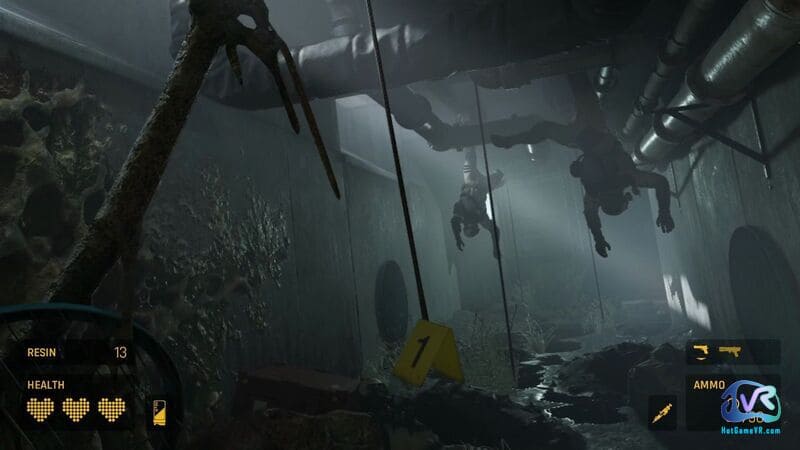
The physicality of manually rotating knobs and connecting circuits enhances the immersion, transforming abstract problem-solving into a tactile, almost meditative experience.
Environmental interaction takes this physicality to another level. Imagine reaching through a broken window to unlock a door from the inside, feeling the strain and tension as you stretch to achieve your goal.
Such moments aren’t just interactive; they’re organically integrated into the storyline, making every solved puzzle feel like a narrative advancement. This method cleverly avoids the pitfall of puzzles feeling like arbitrary obstacles, ensuring they always contribute to the broader mission.
The replayability of these puzzles is another stroke of genius. Just as a magician never reveals the trick behind the illusion, Alyx’s puzzles don’t lose their charm even after repeated playthroughs. Each interaction, from positioning mirrors to reflect lasers to navigating dark, maze-like environments with your flashlight, remains engaging because they demand a mix of logic, observation, and dexterity.
Drawing a comparison to earlier entries in the series, Half-Life 2 also featured puzzles, but they were primarily physics-based, like moving crates or using a gravity gun to organize items.
In Alyx, the puzzles are more nuanced and integrate the unique mechanics of VR, offering a richer, more layered challenge.
The need to physically move, balance, and adjust objects in 3D space creates a deeper level of engagement, making you feel like an active participant in solving the mysteries of City 17.
Examples of Puzzle Mechanics in Alyx:
- Circuit Puzzles: Use the multitool to connect power nodes.
- Mirror Alignment: Adjust reflective surfaces to direct light beams.
- Environmental Navigation: Use physical movement to unlock pathways.
- Interactive Objects: Push, pull, and twist objects to solve complex combinations.
This compelling blend of puzzles and environmental interaction transforms Half-Life: Alyx into a masterclass of immersive gameplay design, forcing you to think creatively and react physically, all while advancing an engaging storyline.
Health and Ammo Management
Managing health and ammunition in Half-Life: Alyx is a meticulous affair, demanding strategic awareness and resourcefulness. Much like a chess player contemplating future moves, you’re often forced to anticipate encounters and conserve supplies, adding an extra layer of tension and strategy to the game.
Health Management: Your health bar serves as a constant reminder of your vulnerability. Finding health kits, which are scattered throughout the environment, becomes a critical part of your exploration.
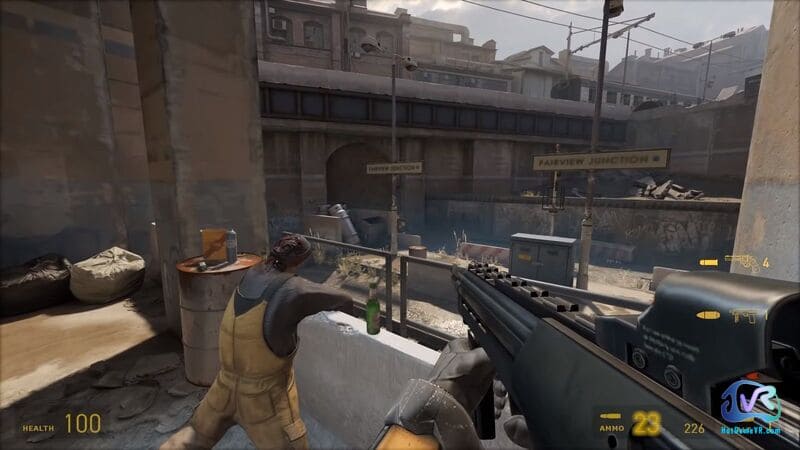
Imagine crawling through dusty vents or rummaging through dilapidated cabinets, each item potentially a lifeline. The game’s careful placement of these resources means you’re often traversing perilous areas, knowing a health kit might be the only thing keeping you from certain death.
Another dimension to health management is the interaction with environmental objects like gas masks and hard hats. These items offer temporary protection, akin to a knight’s armor in combat.
They provide an additional buffer against damage but require you to constantly assess your surroundings and gather these protective assets. It’s as if every piece of trash and scrap can turn into a shield, and recognizing these opportunities can mean the difference between life and death.
Ammo Management: Much like health kits, ammunition is a scarce commodity in Alyx’s world. You’ll find it tucked away in the strangest of places inside filing cabinets, behind supply crates, and even on the fallen bodies of your enemies.
Tactical ammo management becomes a game in itself, much like rationing food during a long hike. You need to balance your usage across different weapons, ensuring you don’t run dry when you need them most.
Gone are the days when you could spam bullets without a second thought. Here, every shot counts. The meticulous reloading process, working with limited rounds, and scavenging for more, brings an element of survival horror into what is ostensibly a sci-fi action game.
It makes every encounter a high-stakes battle, every bullet a precious resource.
Movement Options in VR: The game also offers multiple locomotion methods:
- Blink (Teleport): Swiftly move to a new point, ideal for preventing motion sickness.
- Shift: A quick dash to a targeted spot, maintaining some sense of pace.
- Continuous Locomotion: Mimics natural movement, ideal for those accustomed to traditional FPS mechanics.
- Continuous Hand: Movement guided by your hand’s orientation, giving a new layer of control.
The customization of these movement options ensures that each player can adjust the experience to their comfort level, reducing the common VR issues like motion sickness.
This flexibility makes it easier to immerse yourself in the world and focus on managing health and ammo without the distraction of physical discomfort.
By making resource management an integral aspect of gameplay, Half-Life: Alyx enhances the immersion and complexity, turning every health kit and ammo stash into a potential game-changer.
As with chess, foresight, and strategy are your allies, making each step you take towards defeating the Combine a well-thought-out move in a broader, intricate game.
Narrative Elements
Half-Life: Alyx excels in weaving a powerful narrative filled with richly developed characters, deeply rooted themes, and intricate environmental storytelling. The fusion of these elements results in an emotionally engaging experience that captures the player’s imagination, much like a gripping novel you can physically step into.

The narrative is intricately connected to the gameplay, with characters and environments revealing layers of lore and plot, ensuring that every action, every puzzle, and every combat scenario feels like a part of a larger story.
Storyline Overview
The story of Half-Life: Alyx is set five years before the events of Half-Life 2, offering a prequel that not only deepens the lore but also enhances the emotional stakes of the series.
You step into the shoes of Alyx Vance, a key figure in the resistance against the alien Combine. Her mission is primarily driven by the need to rescue her father, Eli Vance, and uncover the secrets of a mysterious superweapon.
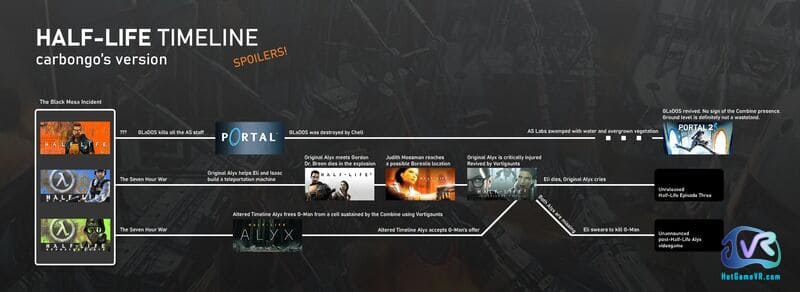
Beginning: The narrative kicks off with Alyx undertaking reconnaissance missions, capturing the daily struggles of resistance life. This section serves as an introduction to the nuances of the game’s VR mechanics and sets the emotional tone. Eli and Alyx’s close relationship is poignantly established, making the stakes personal from the very start.
Middle: As Alyx ventures deeper into the hostile environments of City 17, the game presents varied challenges, evolving from straightforward combat scenarios to intricate environmental puzzles. This phase is rich with lore reveals and surreal encounters, hinting at a broader conspiracy involving the Combine, and even references to the legendary Gordon Freeman.
Climax: The climax is situated within the Vault, a floating fortress brimming with secrets and dangers. Here, Alyx faces off against some of the most challenging enemies, and the narrative reaches a fever pitch with the revelation involving the enigmatic G-Man. This interaction not only deepens the mystery surrounding the Combine’s plans but also sets up significant future narrative threads.
Conclusion: The game concludes with a dramatic twist, involving the G-Man placing Alyx in stasis, altering her fate and that of her father. This ending not only acts as a bridge to the events of Half-Life 2 but also opens up tantalizing possibilities for future installments, leaving players both satisfied and eager for more.
The story is driven by richly crafted characters and their interactions, supported by meticulous environmental storytelling. Every piece of graffiti, every abandoned room in City 17 adds a layer to the narrative, painting a vivid picture of a world under oppressive alien rule.
This complexity ensures that the narrative elements are not just superficial layers but integral components that enrich the gameplay, making Half-Life: Alyx a standout example of narrative design in VR gaming.
Key Characters and Their Roles
Characters in Half-Life: Alyx breathe life into its intricate narrative, each playing vital roles that propel the story forward while enhancing the emotional depth.
Unlike many other FPS games where characters serve mainly as exposition vehicles, here, they are rich, dynamic, and deeply intertwined with the gameplay mechanics.
Alyx Vance: The protagonist, Alyx, is portrayed as a resourceful and brave leader of the Resistance. Her skills as a scientist and her unwavering resolve make her the central figure around whom the narrative swirls.

Whether she’s hacking Combine systems or strategizing against their forces, Alyx’s multi-dimensional character provides players with a hero whose flaws and strengths are relatable.
Her close relationship with her father, Eli, adds layers of emotional stakes, making her journey deeply personal.
Eli Vance: Eli’s role extends beyond just being Alyx’s father. He is a guiding force within the Resistance and a symbol of hope for many.

The emotional core of the game often hinges on Alyx’s interactions with Eli, reflecting themes of family loyalty and the sacrifices made for a greater cause. His wisdom and determination influence Alyx, making him a pivotal character in pushing the narrative forward.
G-Man: The mysterious G-Man is an enigma, whose motives and affiliations remain unclear. His interactions with Alyx, particularly the mind-bending encounter in the Vault, introduce a twist to the narrative, leaving players with more questions than answers.

The G-Man’s ability to manipulate time and space adds an element of the supernatural to the game, contrasting sharply with its otherwise grounded sci-fi setting.
Russell: Introduced as Alyx’s tech-savvy companion, Russell provides comic relief and invaluable support throughout the game. As a mentor figure, he equips Alyx with essential tools like the Gravity Gloves and offers moral support.

His character adds a layer of camaraderie, making the moments of isolation and tension more bearable for both Alyx and the player.
Vortigaunts: These alien allies play crucial roles in aiding Alyx, providing cryptic advice and helping her navigate the treacherous paths of City 17.
Their complex relationship with humanity, shaped by prior enslavement and mutual goals against the Combine, adds a nuanced layer to the narrative, showcasing themes of unity in the face of oppression.
| Character | Role | Key Traits |
|---|---|---|
| Alyx Vance | Protagonist | Resourceful, brave, emotionally driven |
| Eli Vance | Guide and father | Wise, determined, symbol of hope |
| G-Man | Enigma | Mysterious, manipulative, supernatural |
| Russell | Ally and mentor | Tech-savvy, supportive, comic relief |
| Vortigaunts | Alien allies | Cryptic, loyal, powerful |
These characters, with their distinct roles and personalities, enrich the narrative, turning it into a rich tapestry that is as compelling as it is intricate. Each interaction adds depth to the storyline, making each victory feel meaningful and every loss a poignant moment in the grander scheme of resistance against the Combine.
Connection to Half-Life Series Timeline
Half-Life: Alyx slots seamlessly into the broader timeline of the Half-Life series, offering both a prequel to Half-Life 2 and a crucial bridge that deepens the lore and sets the stage for future narratives.
This alignment within the timeline is essential for both longtime fans and new players, providing context and continuity amidst a complex storyline.

Set five years before the events of Half-Life 2, Half-Life: Alyx explores a world still reeling from the Black Mesa incident, where the Combine’s occupation of Earth is firm and seemingly unbreakable.
Alyx’s mission to rescue her father, Eli, and seize a powerful Combine superweapon adds layers of depth to events previously referenced in the series.
Prequel Insights: By stepping into the shoes of Alyx, players gain unique insights into her character development, her relationships, and the Resistance’s early struggles. These elements, briefly touched upon in Half-Life 2, are now fully fleshed out, providing a more comprehensive understanding of the series’ world and its inhabitants.
Bridging the Narrative: The events of Half-Life: Alyx serve as a narrative bridge, linking the original Half-Life’s aftermath with the cataclysmic events starting Half-Life 2. This includes crucial references to characters like Gordon Freeman, who remains a figure of legend and hope throughout the game. The story arc involving the G-Man also establishes new lore that affects the broader timeline, particularly through the altered fate of Alyx and Eli.
Establishing Future Plotlines: The game’s conclusive twist involving the G-Man and Alyx’s stasis hints at profound implications for future installments. This not only enriches the series’ existing lore but also sets up pivotal plot points for potential sequels, including the long-anticipated Half-Life 3. These elements create a narrative continuitythat satisfies both long-time fans and newcomers, ensuring the series remains relevant and engaging.
Major Timeline Elements:
- Black Mesa Incident: The resonance cascade incident at Black Mesa is the catalyst for the Combine invasion. Referenced heavily throughout the series, its impact is felt deeply in Half-Life: Alyx.
- Combine Occupation: The game’s setting explores the early years of the Combine’s dominance, revealing the extent of their control and the humanity’s struggle against it.
- Resistance Building: Alyx’s actions contribute significantly to the Resistance’s formation and strategies, highlighting the crucial role she plays in the war against the Combine. This period is crucial for understanding the resistance’s growth leading up to Half-Life 2.
- Interactions with G-Man: The enigmatic G-Man’s interventions at key moments tie directly into his obscure motives and influence over the series’ events. His manipulations of Alyx’s fate foreshadow pivotal developments in the saga’s ongoing narrative.
By placing Half-Life: Alyx within an elaborately constructed timeline, Valve ensures that each game not only stands on its own but also reinforces the comprehensive lore, creating a cohesive and immersive universe.
Major Themes and Motifs
Half-Life: Alyx masterfully interweaves significant themes and motifs that elevate its narrative depth, making the game an emotionally rich and intellectually stimulating experience. Central themes like resistance, sacrifice, and identity are explored through both character arcs and environmental storytelling, enriching the player’s journey and providing fertile ground for reflection.
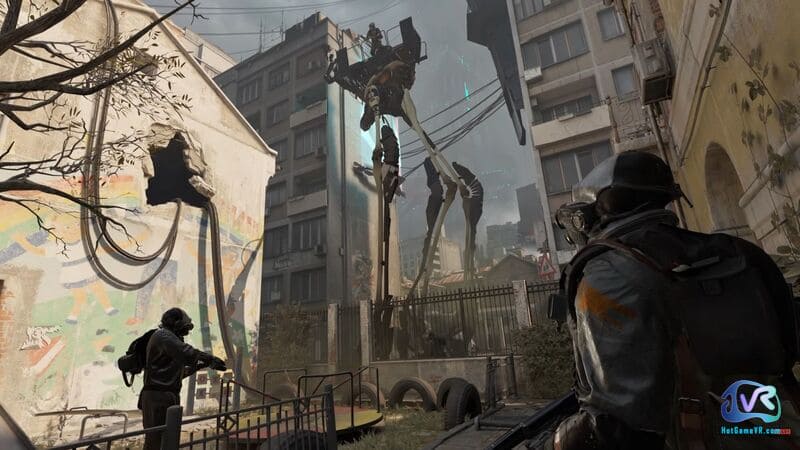
Resistance and Rebellion: This is the core theme of Half-Life: Alyx, and it permeates the entire narrative. The game emphasizes the human spirit’s resilience in the face of overwhelming oppression. Alyx’s journey is a microcosm of the broader resistance movement against the Combine’s tyrannical regime. Much like historical resistance movements, every small victory against the Combine feels monumental, symbolizing hope and the fight for freedom.
Sacrifice and Loss: Half-Life: Alyx digs deep into the personal sacrifices made during conflict. This theme is particularly poignant in Alyx’s relationship with her father, Eli. Their close bond highlights the emotional toll of resistance, making every danger they face a test of their endurance and commitment. Scenes of sacrifice, whether it’s risking life for the greater good or enduring hardship to save loved ones, are imbued with emotional weight, resonating with the player long after the game is over.
Identity and Agency: Alyx’s journey is not just a fight against the Combine but also an exploration of her identity and agency. Throughout the game, she evolves from a skilled scientist to a key figure in the resistance. This evolution is reflected not just in her actions but in her interactions with other characters and the environment. The manipulative presence of the G-Man challenges concepts of fate and autonomy, raising questions about control and free will.
Technological Influence: The dual nature of technology is prominently featured in Half-Life: Alyx. On one hand, tools like the Gravity Gloves empower Alyx, making technology a means of liberation. On the other, the oppressive surveillance and control exerted by the Combine underscore technology’s potential for tyranny. This juxtaposition mirrors contemporary societal debates on technology’s role, highlighting its capacity to both empower and oppress.
Environmental Storytelling: The game’s rich environments serve as more than just backdrops but as narrative devices. Each location in City 17, from the eerie quarantine zones to the majestic Vault, tells a story through its design. Graffiti, abandoned homes, and remnants of struggle all contribute to the overarching narrative, providing a visceral sense of the impact of the Combine’s occupation. It’s akin to exploring a historical battlefield, where every artifact and scar tells a part of the story.
Motifs of Hope and Despair: These motifs play out against the backdrop of a dystopian world. While Alyx’s journey is filled with moments of hope discovering allies, finding crucial information, and small victories the ever-present threat of the Combine ensures a constant tension between hope and despair. This duality keeps the player emotionally engaged, making every success feel harder earned and every setback a stark reminder of the stakes.
By weaving these major themes and motifs into the fabric of its gameplay and narrative, Half-Life: Alyx offers a rich, multilayered experience. This thoughtful integration ensures that players are not just engaged on a gameplay level but are also emotionally and intellectually invested in Alyx’s journey.
Technical Aspects
The technical aspects of Half-Life: Alyx are pivotal in creating its immersive experience. From the scalable power of the Source 2 engine to the sophisticated VR integrations, each technical element is finely tuned to deliver a seamless, engaging gameplay experience. Here’s a summary highlighting these key aspects:
Source 2 Engine Features:
- Advanced lighting and rendering for realistic environments.
- Dynamic environmental interactions and object manipulation.
- High-level physics interactions enhancing immersion.
VR Integration and Comfort:
- Multiple locomotion options to cater to different comfort levels.
- Intuitive VR mechanics, like manual weapon reloading.
- Customizable settings for an individualized experience.
Graphics and Visual Fidelity:
- Detailed textures and realistic lighting creating a believable world.
- Dynamic environmental effects enhancing immersion.
AnimGraph Animation System:
- Node-based structure for complex animations.
- Real-time updates based on game inputs, ensuring fluid character interactions.
Source 2 Engine features
The Source 2 engine, a powerhouse behind Half-Life: Alyx, is the cornerstone of its impressive technical achievements. This engine enables realistic physics, dynamic lighting, and intricate environmental interactions, creating the bedrock for the game’s immersive world.
One of the standout features of the Source 2 engine is its advanced physics simulation. Every object in the game world reacts realistically to player interactions, much like real-world counterparts. This is particularly evident with the Gravity Gloves, which allow players to manipulate objects from a distance.
Imagine pulling a distant object towards you, feeling the weight and inertia through tactile VR feedback it’s akin to using a tractor beam in a sci-fi setting but grounded in believable physics.
Lighting and rendering are other areas where the Source 2 engine excels. The game employs Global Illumination, which accurately simulates how light interacts with surfaces, creating realistic shadows and reflections. This means walking through a dimly lit room feels genuinely eerie, as shadows play tricks on your eyes, enhancing the atmosphere of tension and anticipation.
The engine also boasts high-level environmental interaction, allowing players to interact with the world in meaningful ways. For example, you can smash crates to find hidden resources or use environmental objects as makeshift weapons.
This level of interaction makes the world feel alive and responsive, blurring the line between gameplay and narrative.
Notable Features of the Source 2 Engine:
- Physics Simulation: Realistic object interactions, enhancing gameplay immersion.
- Global Illumination: Advanced lighting effects for realistic environments.
- Dynamic Rendering: High-quality textures and smooth frame rates, even in complex scenes.
- Environmental Interaction: Meaningful player-world interactions, such as breaking objects or hacking systems.
Comparatively, the Source 2 engine’s capabilities outshine those of many other game engines used in VR. While engines like Unity and Unreal Engine 4 offer robust VR support, they often rely on third-party plugins and tools to achieve the same level of fidelity and physics simulation that comes natively with Source 2.
This native integration ensures a smoother, more consistent experience, free from the potential pitfalls of external add-ons.
By offering these advanced features, the Source 2 engine helps Half-Life: Alyx deliver an experience that feels both groundbreaking and polished.
The engine’s robustness and flexibility ensure that each element, from lighting to physics, works harmoniously to create an immersive and visually stunning game world that stands as a benchmark for future VR titles.
VR Integration and Comfort
The VR integration in Half-Life: Alyx sets a new standard in comfort and immersion, showcasing how VR can transform gameplay into a deeply engaging experience.
Valve meticulously crafted the game’s VR mechanics to ensure they felt natural and intuitive, addressing common VR discomforts and enhancing player immersion.
VR Mechanics: The game leverages unique VR capabilities like manual weapon reloading and physical object manipulation. Picture yourself in a firefight, physically ducking behind cover, reloading your pistol by ejecting the magazine and snapping a new one in place it’s a level of tactile engagement rarely achieved in VR. This attention to detail makes every action feel visceral and real, bridging the gap between virtual and physical worlds.
One of the key elements in Half-Life: Alyx is its emphasis on comfort. VR gaming often poses challenges like motion sickness, which can detract from the experience. Alyx addresses this with several customizable locomotion options, allowing players to choose their preferred movement method, including teleportation, shift, and continuous movement. These options ensure that players can find a setting that minimizes discomfort, making the VR experience more accessible to a wider audience.
Locomotion Options:
- Teleportation: Instantly move to a selected location, ideal for those prone to motion sickness.
- Shift: Quick linear movement, preserving orientation and reducing disorientation.
- Continuous Movement: Smooth, joystick-guided movement for those accustomed to traditional FPS controls.
Moreover, Valve has included adaptive settings that allow players to tweak interaction sensitivity, adjust comfort levels, and customize in-game VR settings. This flexibility ensures that players can tailor the experience to their individual preferences, maximizing comfort and immersion. For example, interaction with high vertigo-inducing scenarios, like dealing with Barnacles, can be adjusted to lessen the potential discomfort.
Comfort Settings:
- Adjustable sensitivity and interaction levels.
- Customizable VR settings for seated or standing play.
- Options to reduce impacts in discomforting scenarios like heights.
Comparing VR implementations, Half-Life: Alyx stands out for its thoughtful integration of player comfort features. While other prominent VR titles like Resident Evil 7 VR and Beat Saber offer compelling experiences, they often lack the same depth of customization for movement and interaction. Alyx’s approach ensures that more players can enjoy its rich, immersive world without the common drawbacks of VR discomfort.
In conclusion, the VR integration in Half-Life: Alyx not only enhances immersion but also sets a high standard for player comfort, ensuring that its groundbreaking gameplay mechanics can be enjoyed by a broader, more diverse audience.
Graphics and Visual Fidelity
Half-Life: Alyx’s stunning visual fidelity sets a new benchmark for VR gaming, showcasing what’s possible when cutting-edge technology meets expert artistry. Using the Source 2 engine’s advanced capabilities, the game offers an intricately detailed world where every visual element is meticulously crafted to enhance immersion and realism.
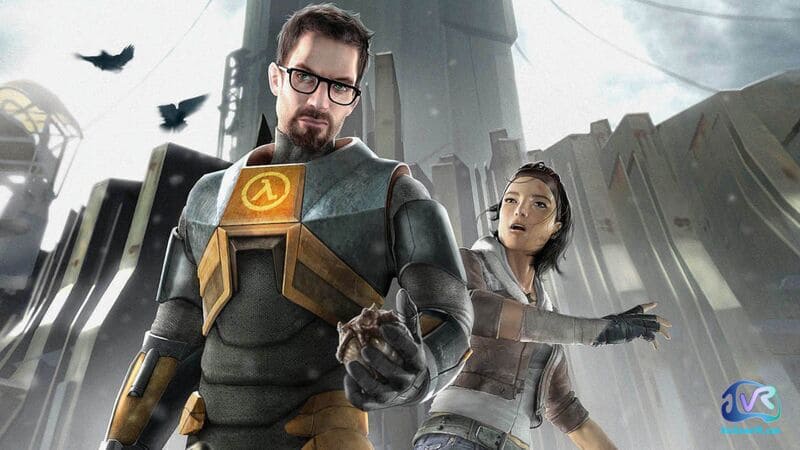
Detailed Textures and Realistic Lighting: The game features highly detailed textures that bring every surface, object, and character to life. Walls show the cracks and grime of a city under siege, and characters exhibit lifelike details down to the finest facial expressions. This attention to detail makes the environments feel lived-in and authentic. The advanced lighting system, including techniques like Global Illumination and Dynamic Shadows, enhances this realism. Imagine walking through a dilapidated building, the sun streaming through broken windows casting dynamic shadows that shift as you move it’s as if you’re truly there.
The game’s visual effects further push the boundaries of VR. Environmental effects like fog, smoke, and particle dynamics add layers of immersion. The way light refracts through dust or how shadows dance during intense firefights enrich the visual experience, making you feel like every inch of City 17 is a character in itself.
Dynamic Environmental Effects:
- Fog and Smoke: Adds atmospheric depth.
- Particle Dynamics: Enhances realism in interactions.
- Texture Detail: Immersive world-building through high-fidelity surfaces.
Comparatively, Half-Life: Alyx surpasses many VR titles in terms of visual fidelity. While games like The Walking Dead: Saints & Sinners and Boneworks offer impressive graphics, they do not match the intricate texture detail and advanced lighting techniques present in Alyx. The Source 2 engine’s optimization ensures that even with such high-level graphics, the game runs smoothly, maintaining a stable frame rate crucial for an immersive VR experience.
One of the crowning achievements in Alyx’s visual design is the way it balances detail with performance. The Source 2 engine’s efficient rendering allows for rich, complex scenes without significant performance hitches. This is essential in VR, where any lag or stutter can break immersion and cause discomfort. Alyx’s smooth performance, even in graphically intense scenes, ensures an uninterrupted, immersive experience.
Visual Fidelity Comparisons:
| Feature | Half-Life: Alyx | Other VR Titles |
|---|---|---|
| Textures | Highly detailed | Moderate detail |
| Lighting | Advanced GI and dynamic shadows | Basic lighting |
| Environmental Effects | Complex, dynamic | Simplified |
| Performance Optimization | High | Variable |
By achieving such high visual standards, Half-Life: Alyx demonstrates the potential of VR technology to create breathtakingly immersive experiences. Its combination of detailed textures, realistic lighting, and dynamic environmental effects ensures that it remains a visually stunning masterpiece, setting a high bar for future VR games to aspire towards.
Animgraph Animation System
The AnimGraph animation system in Half-Life: Alyx sets a new standard for animation quality in VR, creating characters and movements that feel authentic and lifelike. This system uses a node-based architecture that allows for the dynamic composition of animations, ensuring real-time reactions to player interactions and environmental conditions.
Node-Based Structure: At the heart of the AnimGraph system is its node-based architecture, which functions much like a tree structure. Each node performs specific operations like blending animations, applying inverse kinematics (IK), or transitioning between animations. Picture this as a tree with branches representing different animation sequences. The roots receive input from the game environment such as player actions or AI behavior and the final animation is the result of these inputs being processed through the branches to produce a seamless motion.
Parameters and Motors: AnimGraph uses parameters to contextualize animations. For example, if a character is running, the system considers speed, direction, and terrain type. These parameters are continuously updated, allowing characters to adapt dynamically. Motors drive this motion, adapting it based on whether the character is player-controlled or AI, ensuring fluid and natural movements. It’s akin to a puppeteer skillfully orchestrating a marionette’s movements, ensuring each limb moves in harmony with the others.
Playback Control and Previewing: One of the standout features of AnimGraph is its real-time previewing capability during development. This allows animators to visualize and adjust animations on the fly, ensuring that every movement feels just right before it’s finalized. It’s like watching a choreographed dance routine come together in rehearsals before the final performance.
Real-Time Animation Adjustments:
- Node-Based Operations: Sequence blending, IK applications.
- Dynamic Adaptation: Based on game environment and player interactions.
- Preview Mode: Real-time visualization and adjustments.
The visual fidelity achieved by AnimGraph is augmented by techniques like custom motion matching, which ensures that both humanoid and non-humanoid characters move fluidly. For instance, the strider’s giant, mechanical legs walk smoothly across terrain, adapting to slopes and obstacles in real-time. This level of detail ensures that every character’s movements feel authentic, further drawing you into the game world.
Integration with AI: Another significant aspect of AnimGraph is its seamless integration with AI systems. Characters like the Combine soldiers exhibit realistic combat behaviors, using cover intelligently and reacting to player actions with lifelike fluidity. The natural stride retargeting and footstep prediction systems ensure that characters navigate complex terrains smoothly, enhancing the believability of their movements.
Communicating Game States: Animation tags within AnimGraph improve how animations correspond to game states, ensuring that transitions are smooth and contextually accurate. Every jump, dodge, or recoil feels precisely timed, adding to the overall immersion. When Alyx ducks behind cover or examines a mysterious object, her movements are fluid and natural, reinforcing the perception of being inside a living, breathing world.
Comparative Animation Quality:
| Feature | Half-Life: Alyx | Other VR Titles |
|---|---|---|
| Complexity of Animations | High | Moderate |
| Real-Time Adaptation | Dynamic | Limited |
| Integration with AI | Seamless | Basic |
| Visualization and Adjustment | Real-time | Static previews |
With the AnimGraph animation system, Half-Life: Alyx achieves a level of animation realism that is critical for maintaining immersion in VR. This system’s ability to dynamically adjust animations based on real-time inputs ensures that the virtual world feels genuinely alive, further elevating the game’s status as a landmark in VR gaming.
Game Development Insights
Examining Valve’s design philosophy and development approach for Half-Life: Alyx reveals a commitment to player immersion, innovative gameplay, and technological advancements. Their insights into game development offer a roadmap that other VR developers can aspire to emulate.
Design Philosophy of Valve
Valve’s design philosophy, especially evident in Half-Life: Alyx, centers on creating deeply immersive and player-centric experiences. This philosophy influences every aspect of the game, from its storytelling and mechanics to its technical execution.
Immersive Design: Valve approached the design of Half-Life: Alyx with a singular goal: to create an experience that immerses the player fully in the world of City 17. This is achieved through the meticulous design of environments, where every object can be interacted with, and the integration of VR mechanics that feel intuitive and natural. Imagine exploring a derelict building and being able to touch, move, and inspect every item you come across this level of interaction makes the world feel real and immediate.
Player Experience and Agency: A cornerstone of Valve’s philosophy is ensuring that players feel like active participants in the game world. In Half-Life: Alyx, this is reflected in the game’s mechanics, which require physical engagement and decision-making. Players must use their surroundings creatively, whether it’s finding a strategic spot to engage enemies or solving puzzles by manipulating objects. This agency enhances the sense of immersion, making every action feel meaningful and impactful.
Iterative Development and Feedback Loop: Valve’s unique development structure, where team members are free to move between projects based on their expertise, facilitates an iterative process of design and refinement. Half-Life: Alyx underwent continuous playtesting, with mechanics being adjusted based on player feedback. This iterative process ensured that every element of the game, from combat scenarios to puzzle mechanics, felt polished and engaging.
Narrative Integration: Valve aimed to balance nostalgia with new experiences in Half-Life: Alyx. Familiar settings were redesigned with fresh elements to avoid over-reliance on previous titles. The decision to give Alyx a voice, instead of a silent protagonist, was part of a broader effort to deepen character engagement. This narrative integration ensures that players are not just observers but emotionally invested in Alyx’s journey.
Technical Challenges and Innovations: Developing for VR presented unique challenges, from ensuring scale and interaction fidelity to accommodating diverse player heights and perspectives. Valve tackled these by rethinking environmental design and mechanics to make virtual spaces feel physically relatable. The result is an experience where players feel genuinely present in the game world, enhancing immersion and engagement.
Comparative Insights: | Design Aspect | Half-Life: Alyx | Traditional FPS TitlesComparative Insights:
| Design Aspect | Half-Life: Alyx | Traditional FPS Titles |
|---|---|---|
| Immersion | High, VR-centric | Moderate, screen-based |
| Player Agency | High, real-time | Variable, often scripted |
| Iterative Development | Continuous feedback | Fixed milestone iterations |
| Narrative Depth | Rich, integrated | Variable, often linear |
| Technical Innovation | High, VR focus | Variable, hardware-driven |
By adhering to this design philosophy, Valve has managed to push the boundaries of what’s possible in VR gaming, creating an experience that feels both revolutionary and meticulously crafted. Each element, from the detailed environments to the finely tuned mechanics, reflects Valve’s commitment to delivering an unparalleled VR adventure.
Development History of Half-Life: Alyx
The development of Half-Life: Alyx was a monumental endeavor, reflecting Valve’s dedication to innovation and immersive gameplay. The journey from conceptualization to release is a fascinating story of technological advancements, creative iterations, and meticulous attention to detail.
Early Concepts and Focus on VR: The seeds for Half-Life: Alyx were sown in the early 2010s when Valve began experimenting with virtual reality technology. Their partnership with HTC to create the HTC Vive VR headset laid the groundwork for a VR-centric design approach. The initial concept was to develop a game that would harness the unique capabilities of VR, offering an experience that couldn’t be achieved through traditional gaming.
Project Initiation: The project officially began in 2016 with a small team dedicated to exploring VR gameplay mechanics. The choice of Alyx Vance as the protagonist was deliberate, aiming to provide a fresh perspective within the established Half-Life universe. This decision was also influenced by the narrative potential of exploring events that bridged Half-Life and Half-Life 2.
Iterative Development: Valve’s iterative development process was pivotal in refining the game’s mechanics and design. Extensive playtesting informed many of the design choices, from combat mechanics to puzzle-solving elements. The team employed a flexible development structure, allowing team members to shift roles based on their expertise and interests, fostering a collaborative environment where ideas could evolve organically.
Technological Advancements: Utilizing the Source 2 engine enabled the team to create highly detailed environments and advanced physics interactions essential for a compelling VR experience. The development included building tools specifically for VR, such as the VR Editor in the Hammer level design tool, allowing for precise creation and testing of VR environments.
Challenges and Solutions: One of the primary challenges was ensuring player comfort in a VR setting, which led to the incorporation of multiple locomotion options. Additionally, the team had to rethink traditional game mechanics to suit VR, such as reloading weapons manually and interacting with the environment using physical gestures.
Community Engagement: Valve has a long history of fostering strong community engagement, and the development of Half-Life: Alyx was no different. The team used feedback from early access and internal testing to continuously refine the game. Post-release, they provided modding tools, encouraging community-driven content and extending the game’s longevity.
Release and Reception: Released on March 23, 2020, Half-Life: Alyx was met with widespread acclaim. It was lauded for its innovative use of VR, compelling narrative, and immersive gameplay. Its success reignited interest in the Half-Life franchise and set a new benchmark for VR gaming.
Timeline of Development:
| Year | Milestone |
|---|---|
| Early 2010s | VR experimentation and HTC partnership |
| 2016 | Project initiation and concept formation |
| 2016-2020 | Iterative development and playtesting |
| 2019 | Official announcement |
| March 2020 | Game release |
The development history of Half-Life: Alyx is a testament to Valve’s commitment to pushing the boundaries of gaming technology. By embracing VR and continuously iterating based on feedback and technological advancements, Valve has created a landmark title that elevates the standards for immersive gameplay and narrative depth.
Community Modding and User Content
Valve’s commitment to fostering a robust modding community has been a significant aspect of Half-Life: Alyx’s ongoing success. Providing comprehensive tools and encouraging user-generated content has kept the game vibrant and continually fresh, long after its initial release.

Steam Workshop Integration: Valve’s use of the Steam Workshop for Half-Life: Alyx allows players to easily share and access mods. This platform makes it simple for users to download and install new content, fostering a vibrant community of creators and players. Whether it’s new levels, custom skins, or entirely new game modes, the Workshop is a hub of creativity and innovation.
Modding Tools: Shortly after the game’s release, Valve provided a comprehensive suite of modding tools, including the Hammer level editor optimized for VR. These tools allow modders to create detailed environments, unique gameplay scenarios, and custom content. The availability of these tools has empowered the community to expand the game’s horizons, making it a platform for creative expression.
Legacy Method via Source2mod: For those preferring traditional modding methods, Valve supports the legacy modding approach via source2mod. This method involves creating specialized mod folders and customizing content, appealing to experienced modders who enjoy in-depth control over their creations.
Examples of Community-Modded Content:
- Custom Levels: From recreating iconic areas from Half-Life 2 to entirely new environments, modders create levels that offer new challenges and narratives.
- Gameplay Mechanics: Modifications to gameplay mechanics introduce new weapons, enemies, and interaction modes, expanding the core gameplay.
- Visual Enhancements: Custom skins and graphical enhancements allow players to personalize their experiences, from character models to environmental textures.
Engaged Community: The Half-Life: Alyx modding community is active and passionate, consistently producing high-quality content that attracts new players and retains existing ones. Platforms like the Steam Community and various online forums are buzzing with discussions, guides, and showcases of modded content. This engagement keeps the game dynamic, ensuring there’s always something new to explore.
Impact on Longevity: The availability of modding tools and the active community contribute significantly to the game’s longevity. User-generated content keeps the game relevant, providing endless replayability. This continuous influx of new content helps Half-Life: Alyx maintain a dedicated player base and attract new players curious about the latest mods.
Comparative Modding Ecosystem:
| Aspect | Half-Life: Alyx | Other VR Titles |
|---|---|---|
| Tool Accessibility | Comprehensive and user-friendly | Variable, often less robust |
| Community Engagement | High, active modding scene | Moderate, varies by title |
| Content Variety | Extensive, diverse | Limited in scope and quantity |
By nurturing a thriving modding ecosystem, Valve ensures that Half-Life: Alyx not only remains a landmark VR title but also evolves through community contributions. This symbiotic relationship between developers and players fosters a dynamic, ever-expanding game world that continues to captivate and inspire.
Reception and Impact
The reception of Half-Life: Alyx was overwhelmingly positive, both critically and within the player community, marking it as a significant milestone in VR gaming. Its impact extended beyond immediate reviews, influencing future VR titles and setting a new bar for what VR experiences could achieve.
Critical Acclaim and Reviews
Upon its release, Half-Life: Alyx received widespread critical acclaim, hailing it as a groundbreaking achievement in VR gaming. Critics praised its immersive gameplay, innovative use of VR technology, and compelling narrative. The game’s ability to blend the traditional elements of the Half-Life series with the unique capabilities of VR was particularly lauded.
Innovative Use of VR: Reviewers highlighted how Half-Life: Alyx leveraged VR to create an experience unattainable through traditional means. The manual reloading of weapons, physical interaction with the environment, and intuitive use of tools like the Gravity Gloves were seen as revolutionary. These mechanics were not just gimmicks but integral to the gameplay, enhancing immersion and making the world feel real.
Engaging Storytelling: The narrative received high praise for its depth and emotional resonance. Critics noted that the game successfully expanded the Half-Life lore while maintaining the series’ trademark suspense and mystery. The character development of Alyx Vance, her relationship with her father Eli, and the enigmatic presence of the G-Man were particular highlights.
Gameplay Mechanics: The blend of combat, exploration, and puzzle-solving was described as meticulously balanced. Critics appreciated how each element complemented the others, creating a cohesive and engaging experience. The variety of enemies and the strategic use of limited resources like ammunition and health kits added layers of complexity, keeping players on their toes.
Visual and Audio Excellence: The game’s visuals, powered by the Source 2 engine, were universally praised. Detailed textures, realistic lighting, and dynamic environmental effects created a visually stunning world. The sound design, with its spatial audio techniques and high-quality voice acting, further enhanced the immersive experience.
Review Highlights:
- IGN: “A groundbreaking VR experience that sets a new standard for the medium.”
- GameSpot: “A triumph in immersive storytelling and intuitive game design.”
- Polygon: “A must-play for VR headset owners and a landmark entry in the Half-Life series.”
Comparative Reception:
| Aspect | Half-Life: Alyx | Other VR Titles |
|---|---|---|
| Innovativeness | High, VR-centric | Variable, often less advanced |
| Storytelling Depth | Rich, emotionally engaging | Often limited in narrative scope |
| Gameplay Mechanics | Balanced and intuitive | Variable, can be less cohesive |
| Visual and Audio Quality | Excellent, high fidelity | Varies, generally lower fidelity |
The critical acclaim for Half-Life: Alyx solidified its reputation as a landmark VR game, influencing how future titles approached storytelling, gameplay mechanics, and immersive design in virtual reality.
Awards and Recognitions
Half-Life: Alyx’s impact on the gaming landscape was further cemented by the numerous awards and recognitions it garnered post-release. Its innovative approach to VR, coupled with its compelling narrative and gameplay, earned it accolades across various prestigious platforms.
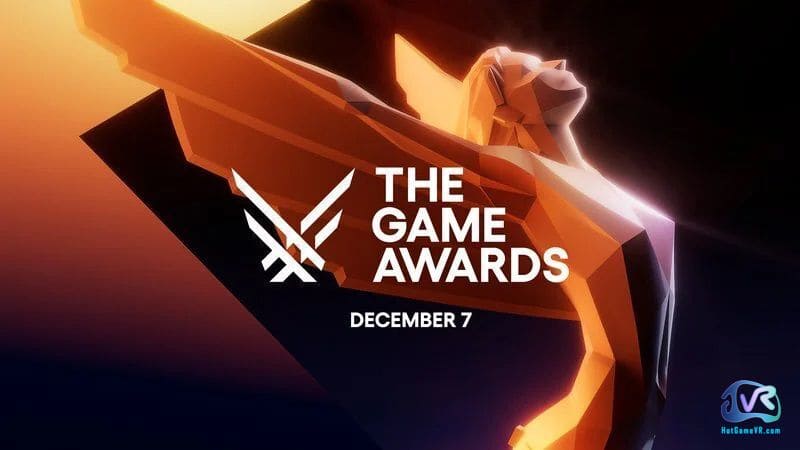
Recognition and Awards:
- The Game Awards 2020: Half-Life: Alyx received the award for Best VR/AR Game, highlighting its pioneering use of virtual reality in creating an immersive gaming experience.
- National Academy of Video Game Trade Reviewers (NAVGTR): The game won the Outstanding Achievement in Game Direction, showcasing its excellence in creative and technical execution.
- Golden Joystick Awards: It was awarded Critics’ Choice and Best Visual Design, underlining its aesthetic and visual triumphs.
- BAFTA Games Awards: Half-Life: Alyx was nominated in several categories, winning the Best Game and Technical Achievement, further validating its innovative approach and technical prowess.
- TIGA Games Industry Awards: It received the Best VR/AR award, solidifying its position as a leading title in the VR space.
Legacy and Impact: The recognition extended beyond these awards, influencing other game developers and VR enthusiasts. It set a high bar for VR experiences, pushing the boundaries of what could be achieved in terms of immersion, narrative depth, and gameplay complexity. The game’s success encouraged other developers to explore the potential of VR more seriously, fostering a new wave of innovation in the industry.
Community Response: The player community’s reception mirrored critical acclaim, with Half-Life: Alyx quickly gaining a dedicated fanbase. The sustained interest and engagement, highlighted by the active modding community and high user ratings, underscored its lasting impact.
Comparative Awards and Recognitions:
| Award Category | Half-Life: Alyx | Other VR Titles |
|---|---|---|
| Best VR/AR Game | Multiple wins and nominations | Fewer recognitions, often niche |
| Outstanding Game Direction | Consistent wins | Rarely achieved in VR category |
| Best Visual Design | High accolades | Lower frequency, often less detailed |
| Community Engagement | High sustained interest | Generally lower, less engaged |
These awards and recognitions are a testament to the game’s groundbreaking achievements and its significant contribution to the evolution of VR gaming. Half-Life: Alyx remains a landmark title, revered for its innovation, narrative depth, and technical excellence.
Community Reception and Player Feedback
The community reception of Half-Life: Alyx has been overwhelmingly positive, reflecting the game’s strong impact on players. The attention to detail, immersive VR mechanics, and engaging storyline have resonated deeply with the community, fostering a dedicated and active player base.
Positive Feedback:
- Immersive Experience: Players consistently praise the game’s ability to transport them into the world of City 17. The detailed environments, interactive elements, and realistic physics contribute to a sense of immersion that many players describe as unparalleled in VR gaming.
- Engaging Storyline: The narrative, centered around Alyx’s journey and her relationships, has been a significant talking point. Players appreciate the emotional depth and development of characters, particularly the dynamic between Alyx and her father, Eli, and the mysterious G-Man.
- Intuitive Mechanics: The game’s mechanics, from combat to puzzle-solving, are highlighted as intuitive and satisfying. The use of the Gravity Gloves and the manual reloading of weapons are frequently mentioned as standout features that enhance the VR experience.
- Visual and Acoustic Quality: The high-fidelity graphics and immersive sound design have left a lasting impression on players, contributing to the overall realism of the game.
User Reviews and Community Engagement: On platforms like Steam, Half-Life: Alyx boasts overwhelmingly positive reviews. As of [Specific Date], the game maintains a high average rating, with thousands of players praising its innovative design and execution. Discussions in community forums often highlight memorable moments and exchange tips for gameplay and modding.
Sustained Interest: The continuous production of user-generated content, facilitated by Valve’s modding tools, has kept the game vibrant. Players regularly share their creations, from custom levels to gameplay modifications, maintaining a dynamic and engaging community.
Comparative Player Feedback:
| Aspect | Half-Life: Alyx | Other VR Titles |
|---|---|---|
| Immersive Experience | Highly praised | Variable, often less immersive |
| Engaging Storyline | Deep, emotionally resonant | Often limited or superficial |
| Intuitive Mechanics | Consistently highlighted | Mixed, sometimes clunky |
| Visual and Acoustic Quality | Superior, high fidelity | Generally lower, variable |
| Community Engagement | Active, vibrant modding scene | Less frequent, limited mods |
The enthusiastic community reception and sustained player engagement underscore the lasting legacy of Half-Life: Alyx. Its ability to captivate players, combined with a supportive modding ecosystem, ensures it remains a vital, living part of the VR gaming landscape.
Related Technologies
The success of Half-Life: Alyx and its advanced use of VR have shone a spotlight on the related technologies that make such immersive experiences possible. Compatibility with various VR headsets, stringent performance requirements, and the future trajectory of VR gaming are critical elements that enhance and sustain the VR experience.
VR Headset Compatibility
Half-Life: Alyx is designed to be compatible with a wide range of VR headsets, making it accessible to a broad audience. This inclusivity ensures that players with different hardware setups can experience the game’s rich, immersive world without being restricted to a specific VR system.
Supported VR Headsets:
- Valve Index: Known for its advanced finger-tracking controllers and high-quality optics, the Valve Index offers the best experience for Half-Life: Alyx. The external base station tracking provides precise movement accuracy, enhancing immersion.
- Oculus Series:
- Oculus Rift (Original) and Oculus Rift S: Both headsets provide a seamless experience with Half-Life: Alyx. The Rift S, with its inside-out tracking, eliminates the need for external sensors, making setup simpler.
- Oculus Quest: When connected to a VR-ready PC via Oculus Link, the Quest delivers a robust Alyx experience. This flexibility makes it a popular choice for players seeking both standalone and PC-tethered VR capabilities.
- HTC Vive: The HTC Vive, along with its Pro and Cosmos variants, is fully compatible with the game. The use of external base stations for tracking ensures accurate and reliable movement tracking.
- Windows Mixed Reality Headsets: Various models from manufacturers like Acer, Dell, Lenovo, and Samsung are supported. These headsets offer a budget-friendly option without compromising too much on quality.
- Pimax: Known for their high-resolution displays and extensive field of view, Pimax headsets cater to players seeking the utmost in visual detail and peripheral vision.
Technical Requirements and Compatible Headsets:
| VR Headset | Features | Experience Quality |
|---|---|---|
| Valve Index | Advanced optics, finger tracking, external base stations | Best |
| Oculus Rift/Rift S | Inside-out tracking, PC compatibility | Excellent |
| Oculus Quest | Hybrid standalone/PC-tethered, Oculus Link | Very Good |
| HTC Vive | External base stations, wide compatibility | Excellent |
| Windows MR | Budget-friendly, adequate tracking | Good |
| Pimax | High resolution, wide FOV | Excellent |
Gameplay Mechanics:
- Interaction: Alyx supports various controller types, from advanced finger-tracking controllers of the Valve Index to simpler trigger-based ones from the older Oculus and HTC systems.
- Locomotion Options: The game supports multiple movement methods, including teleportation, shift, and continuous locomotion, ensuring compatibility with different player preferences and helping to mitigate potential motion sickness.
By ensuring such broad compatibility, Half-Life: Alyx allows more players to experience its groundbreaking VR gameplay, making the game a cornerstone in VR’s growing ecosystem.
Performance Requirements
The performance requirements for running Half-Life: Alyx are designed to ensure a smooth and immersive VR experience. Below are the minimum and recommended specifications to maximize the game’s potential.
Minimum PC Specifications:
- Operating System: Windows 10
- Processor (CPU): Intel Core i5-7500 or AMD Ryzen 5 1600
- Memory (RAM): 12GB
- Graphics Card (GPU): Nvidia GeForce GTX 1060 (6GB VRAM) or AMD Radeon RX 580 (8GB VRAM)
Recommended PC Specifications:
- Operating System: Windows 10
- Processor (CPU): Intel Core i7-9700K or AMD Ryzen 5 3600
- Memory (RAM): 16GB
- Graphics Card (GPU): Nvidia GeForce GTX 1070 / RTX 2060 or AMD Radeon RX Vega 56 / RX 5700
These stringent requirements reflect the game’s detailed environments and high level of interactivity. Ensuring a stable frame rate and minimizing frame times is crucial foran immersive VR experience. For those meeting only the minimum specifications, the game may need to run on lower graphical settings to maintain fluid performance, which is essential to avoid VR-induced discomfort like motion sickness. The recommended specifications ensure a seamless experience with high-quality visuals, preserving the game’s intended immersive impact.
Optimization Tips:
- Graphics Settings: Lowering certain graphical settings like shadows, texture quality, and post-processing effects can help improve performance on lower-end systems. This allows the game to run smoothly while maintaining an acceptable level of detail.
- Driver Updates: Keeping GPU drivers up to date is crucial for ensuring compatibility and optimizing performance. Manufacturers like Nvidia and AMD regularly release driver updates to improve game performance and fix issues.
- System Maintenance: Regularly closing background applications, cleaning up system storage, and ensuring the system’s cooling is effective can help maximize performance.
Comparative Hardware Requirements:
| Specification | Minimum Requirements | Recommended Requirements |
|---|---|---|
| Operating System | Windows 10 | Windows 10 |
| CPU | Intel i5-7500 / AMD Ryzen 5 1600 | Intel i7-9700K / AMD Ryzen 5 3600 |
| RAM | 12GB | 16GB |
| GPU | GTX 1060 (6GB) / RX 580 (8GB) | GTX 1070 / RX Vega 56 |
The rigorous performance requirements underscore the game’s reliance on robust hardware to deliver its exceptional VR environment, pushing players to consider upgrades to fully appreciate its graphical fidelity and interactive depth.
Future of VR Gaming Post-Alyx
Half-Life: Alyx has undeniably set a high standard, influencing the trajectory of VR gaming and inspiring future developments in the technology. Here’s a look at the potential advancements and trends in VR gaming following Alyx’s impact:
Enhanced Graphics and Performance: As VR technology continues to evolve, future games are likely to leverage advancements in GPU capabilities, such as the Nvidia RTX series’ ray tracing technology. These improvements can lead to even more realistic environments and dynamic lighting effects, as seen in Half-Life: Alyx. Such enhancements will push VR gaming closer to photorealism, deepening immersion.
Advanced VR Headsets: Companies are continually developing more advanced VR headsets, with higher refresh rates, better resolution, and improved tracking systems. For instance, headsets with 4K resolution per eye and 144Hz refresh rates are on the horizon, promising a more fluid and visually striking experience. These advancements will address existing challenges such as screen door effect and motion sickness, providing a more comfortable and engaging gaming experience.
Haptic Feedback and Realistic Interactions: Future VR games will likely incorporate more sophisticated haptic feedback systems, enabling players to feel sensations like resistance, texture, and force through their controllers or other peripherals. This technology has the potential to revolutionize interaction, making activities like handling weapons, manipulating objects, or even feeling environmental effects far more immersive.

Expanded Accessibility and Cross-Platform Play: Following the inclusive approach of Half-Life: Alyx, future VR titles may prioritize cross-platform compatibility and customization options to cater to diverse player preferences and physical capabilities. This ensures a broader audience can enjoy VR gaming, encouraging community growth and participation.
Innovative Game Mechanics: The success of Alyx’s mechanics, such as the Gravity Gloves and manual reloading, highlight the potential for innovative gameplay features that fully utilize VR’s unique capabilities. Future games will likely explore new ways to engage players physically and mentally, integrating mechanics that aren’t possible in non-VR mediums. This includes intricate puzzles, nuanced combat systems, and more interactive narratives.
Virtual Social Spaces and Multiplayer Experiences: As VR technology advances, social aspects of gaming may become more prominent. Imagine fully immersive VR multiplayer experiences where players can interact in virtual environments with unparalleled realism. Platforms like VRChat and Rec Room already hint at this future, but advancements in VR tech will make these interactions smoother, more engaging, and more widespread.
Comparative Outlook on VR Gaming Advancements:
| Aspect | Present (Post-Alyx) | Future Direction |
|---|---|---|
| Graphics and Performance | High fidelity, RTX support | Photorealism, advanced ray tracing |
| VR Headset Technology | Various, up to 120Hz, 2K resolution | 4K per eye, 144Hz, extensive FOV |
| Interaction and Haptics | Basic feedback, manual interactions | Advanced haptics, realistic feedback |
| Accessibility | Broad compat., movement options | Expanded cross-platform, accessibility features |
| Game Mechanics | Innovative, VR-centric | New, unique VR mechanics |
| Social and Multiplayer | Emerging VR social platforms | Comprehensive virtual social spaces |
Reaping the benefits of Half-Life: Alyx’s innovations, the future of VR gaming looks bright. Enhanced realism, deeper interactivity, and broader accessibility are poised to redefine gaming, making VR a mainstream fixture in the gaming industry.
Conclusion
Half-Life: Alyx represents a landmark achievement in VR gaming, pushing the boundaries of immersive gameplay, storytelling, and technical sophistication. By leveraging the advanced features of the Source 2 engine, intuitive VR mechanics, and a rich narrative deeply woven into the Half-Life universe, Alyx has set a new standard for what virtual reality can accomplish.
The game’s intricate puzzles, strategic combat scenarios, and emotionally compelling story have resonated with both critics and players, earning widespread acclaim and numerous awards.
Valve’s meticulous design philosophy, iterative development process, and commitment to player comfort have resulted in a highly polished experience that exemplifies the potential of VR.
The active modding community and the game’s broad VR headset compatibility ensure that Half-Life: Alyx remains a dynamic and enduring entry in the gaming landscape, fostering ongoing engagement and creativity.
As the VR industry continues to evolve, the advancements and innovations introduced by Half-Life: Alyx are likely to influence future developments in VR technology, paving the way for even more immersive, accessible, and engaging gaming experiences.
The game’s success not only revitalizes the Half-Life franchise but also sets a high bar for future VR titles, making it a seminal work that will be studied and celebrated for years to come.
By exploring the detailed mechanics, narrative depth, and technical achievements of Half-Life: Alyx, it’s clear that the game is more than just a VR experience it’s a pivotal moment in the history of gaming, demonstrating the profound impact that well-executed VR can have on storytelling and player immersion.
As we look to the future of VR gaming, the legacy of Half-Life: Alyx will undoubtedly continue to inspire and shape the path forward.
Learn Extra
- Best VR Game 2024
- Fortnite vs GTA : Which Recreation is Higher 2022
- 10+ Rumbleverse Ideas Free We Want You Knew Earlier than Beginning
- MultiVersus Information: Gameplay, Perks and Each Playable Character
- Professional-blockchain narratives hinder Bitcoin adoption, says StackinSat founder
- What’ll occur in Poppy Playtime chapter 3? Who’s PROTOTYPE – 1006 ? Obtain Free
- Get probably the most Costly Fortnite Skins simply 0$-At present Replace


